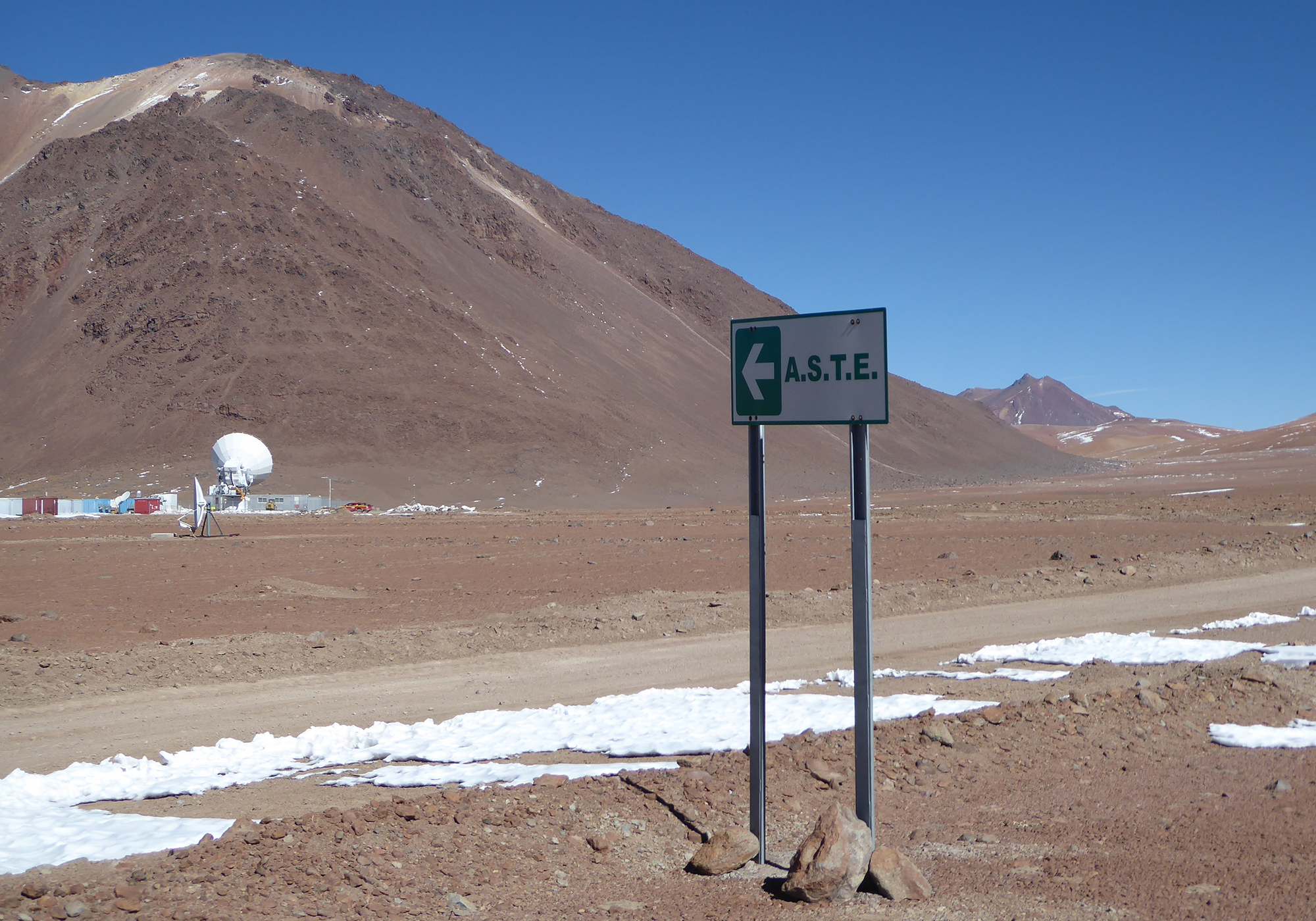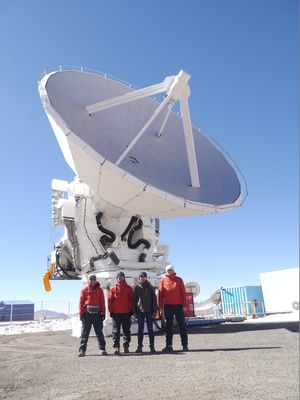The DESHIMA guide to the galaxy

Astronomers looking to find out more about the early beginnings of our universe need to measure infrared light which has taken between 2 and 10 billion years to reach earth. Sensitive instruments are required for this. A team from our faculty is working on superconductive and extremely sensitive measurement equipment that can speed up the current measurement process 100-fold. This autumn, they will be travelling to Chile to install and test the equipment. Once it all works, we will be able to create 3D maps of star systems, allowing us to look back in time and space.
|
Instrument Science: a new field
The journey started at the same place back in 2009, at an altitude of nearly 5,000 metres, under a clear sky in the Atacama Desert in Chile. That was when Akira Endo (Terahertz Sensing Group, TU Delft) conceived the idea for a spectrometer with a large number of Microwave Kinetic Inductance Detectors (MKID). Jochem Baselmans later suggested creating the entire spectrometer on the same chip, without using optics: the idea of the superconductive, on-chip spectrometer was born. Endo was originally an astronomer, but soon realised that in order to make truly pioneering discoveries, he would need fundamentally new equipment. He started his research into a superconductive spectrometer with an on-chip filter bank. Endo combines astronomy with the development of superconductive measurement equipment: what he has christened ‘instrument science’.
How it works
The detector at the core of the instrument works using superconductivity. When certain metals are cooled to extremes, the electrons can suddenly form Cooper pairs. These Cooper pairs move without electrical resistance or loss of signal through the metal. To detect far infrared light, we use a subtle effect of superconductors: a change to the kinetic induction and resistance of the superconductive film when light hits it. The DESHIMA chips are fitted with Microwave Kinetic Inductance Detectors (MKID) so that these tiny changes can be measured with great precision. A revolutionary design for separating the colours is also used, the so-called on-chip filter bank. The design of the chips is extremely compact in comparison with an immersed grating spectrometer, for example. The chips are cooled in a cryostat to a temperature of 120 mK. Two mirrors in the cryostat and several outside ensure an efficient link between the telescope and the chip. The detectors are read out using technology developed by the SRON Netherlands Institute for Space Research.
We already have narrowband far infrared spectrometers. What makes DESHIMA special is its instantaneous bandwidth: DESHIMA will be tested in Chile as proof of principle at a frequency of 346 Gigahertz and a bandwidth of 40 Gigahertz. Nobody has ever attempted to use such a large bandwidth to look so far back in time and deep into space. The large instantaneous bandwidth allows DESHIMA to conduct measurements much faster than other types of spectrometer. In a few years’ time, there will ultimately be an instrument working at 240-720 GHz.
The mission: Chile
David Thoen (38) is one of the researchers heading for Chile. Just packing up the whole set-up has taken him a couple of weeks (see text box: A chip with an entourage).
|
After Chile: more pixels
Thoen: ‘With the results from Chile, we will be able to further characterise our system. The chip that we are now going to test has a limited bandwidth, and is in the easiest part of the spectrum, relatively speaking. The next step is a larger bandwidth (240-720 GHz); we already have chips for this, but they are yet to be developed fully. The structures on the current chips are 100 nm thick, and at least two micrometres long or wide. For larger bandwidths, we need to work towards structures with dimensions in the order of nanometres: lines and grooves with widths of 300 nm. We have developed a procedure for this in the clean room. The first chips from the 300 nm generation are now being prepared for measurements in our cryogenic measurement lab in the faculty’s Else Kooi Lab. In addition to adjusting the bandwidth, we can also add more light filters to the chip and expand the current single pixel design to a multi-pixel system. That would be a major upgrade, as DESHIMA is designed for multiple pixels. TU Delft and SRON are working on a second project, called MOSAIC, where the focus is on a large multi-pixel system of 16 or even 25 pixels.
Studying star systems 101
To look at the stars you need a telescope. A spectrometer is like a camera that allows astronomers to measure redshift. Redshift increases with the speed with which the source moves away from the receiver. In the 20th century, Hubble demonstrated that our universe is expanding: the distance between earth and nearly all intergalactic objects is increasing. The farther away a star system is from us, the faster it moves away from us: this results in a particular redshift, which is linked to the distance and age of the star system. The speed of light is finite, and the redshift measurements using DESHIMA show us how many billions of years it has taken for the light to reach earth, allowing us to determine the distance to the source. With other multi-pixel far infrared cameras (e.g. AMKID, which TU Delft also worked on), we can produce an intensity image, similar to a black-and-white photograph. With the single-pixel DESHIMA camera, we get a colour photograph, because we look at the source and see the colour spectrum. The redshift reveals the information hidden in the colour spectrum.
A chip with an entourage

The light-sensitive chips are 14 millimetres wide, 42 millimetres long and 0.3 millimetres thick. They will be placed in their holders and transported to Chile as hand luggage. However, DESHIMA needs its full entourage. It only works if the detector chips are superconductive and cooled to a stable temperature of circa 0.120 degrees above absolute zero (-273.0 degrees Celsius). To achieve this, you need a cryostat, in which a vacuum is created to protect the chip from external heat. Infrared heat radiation is given off by everything that is warmer than absolute zero, and that could influence the measurements. The parts of the cryostat are therefore designed in such a way that the detector chip is protected against being affected by parts that are warmer than 120 mK. The thermic-mechanical suspension plays an important role, as it has to prevent mechanical vibrations from influencing the measurements while also keeping the chip extremely cold. The cryostat is optimised to observe far infrared, taking account of indirect light. Light traps ensure that the indirect light is absorbed at innocuous places instead of at places where it could disrupt the measurements. Nothing in the design of DESHIMA has been left to chance. So it is for good reason that the team is travelling to ASTE, one of the best far infrared telescopes in the world.
The team
In the DESHIMA project, TU Delft collaborates closely with the SRON Netherlands Institute for Space Research, Leiden Observatory and the University of Tokyo. Each institution has worked with great dedication and enthusiasm, contributing their specific knowledge and expertise to the realisation of the DESHIMA spectrometer. The DESHIMA project was launched by pioneers Akira Endo (project leader, Terahertz Sensing, TU Delft) and Jochem Baselmans (head of research, Terahertz Sensing, TU Delft and SRON). Other members later joined the team, including David Thoen and Kenichi Karatsu – both from TU Delft, the former for chip production and the latter for measurements. SRON is closely involved with the project, especially Vignesh Murugesan for chip production, Martin Grim for the read-out and Robert Huiting for the mechanical design of the cryostat. Numerous students and post-docs have also contributed to extremely varied research. This ranged from material expertise and clean room processing to new designs for the detector chips, and also included simulating a virtual far infrared universe in order to ascertain the fastest method for scanning the firmament. Master’s student Sjoerd Bosma (TU Delft) graduated late in August with his design for the mirror set for the ASTE telescope. Once the mirror set has been manufactured in Japan, it will be installed in the telescope in mid-October to help maximise DESHIMA’s performance. If you would like to find out more, read the interview with Akira Endo from 2016 and the researcher profiles on the project blog, where you can also follow the researchers during their mission in Chile.
Text: Marieke Roggeveen | Photos: David Thoen and Akira Endo | September, 2017
Epiloque
The campaign in Chili has been extraordinary successful. After the instrument arrived in good order, it has been assembled. On 6 October 2017 it was mounted in the ASTE telescope. On 19 October the astronomical First Light observation on the planet Saturn was performed. These measurements were followed by observations on a variety of astronomical objects, ranging from moon and planets to galactic molecular clouds and high-redshift galaxies.
The results show that the DESHIMA team is well on her route. At the moment the group is preparing DESHIMA 2.0: the full-scale upgrade of the existing prototype is aiming on First Light observation on the ASTE telescope in February 2020.
 In September, the research team will depart for the astoundingly beautiful – and extremely dry – Atacama Desert in Chile. There, at an altitude of 4.8 kilometres, you will find the Japanese Atacama Submillimeter Telescope Experiment (ASTE). A far infrared camera – developed in Delft – will be installed inside the ASTE telescope. This instrument is called DESHIMA, the abbreviation for Deep Spectroscopic High-redshift Mapper. DESHIMA is a spectrometer, designed to determine the distance to far infrared star systems by measuring the redshift of the spectrum of star systems. This allows us to gain a better understanding of how stars are formed in star systems enclosed by matter (see text box: Studying star systems 101). The distances are so great that it takes between 2 and 10 billion years for the light to reach the earth. The developed spectrometer features a previously unseen bandwidth for far infrared light, made possible by a superconductive chip that receives the radiation, filters it into narrower frequencies and detects the power per frequency. DESHIMA is the first spectrometer of its kind to actually be tested on a telescope. If this mission is successful, this autumn, our researchers in Chile will be able to look farther back into time and space than ever before.
In September, the research team will depart for the astoundingly beautiful – and extremely dry – Atacama Desert in Chile. There, at an altitude of 4.8 kilometres, you will find the Japanese Atacama Submillimeter Telescope Experiment (ASTE). A far infrared camera – developed in Delft – will be installed inside the ASTE telescope. This instrument is called DESHIMA, the abbreviation for Deep Spectroscopic High-redshift Mapper. DESHIMA is a spectrometer, designed to determine the distance to far infrared star systems by measuring the redshift of the spectrum of star systems. This allows us to gain a better understanding of how stars are formed in star systems enclosed by matter (see text box: Studying star systems 101). The distances are so great that it takes between 2 and 10 billion years for the light to reach the earth. The developed spectrometer features a previously unseen bandwidth for far infrared light, made possible by a superconductive chip that receives the radiation, filters it into narrower frequencies and detects the power per frequency. DESHIMA is the first spectrometer of its kind to actually be tested on a telescope. If this mission is successful, this autumn, our researchers in Chile will be able to look farther back into time and space than ever before. 